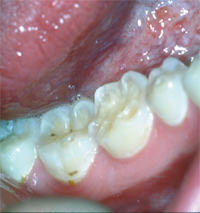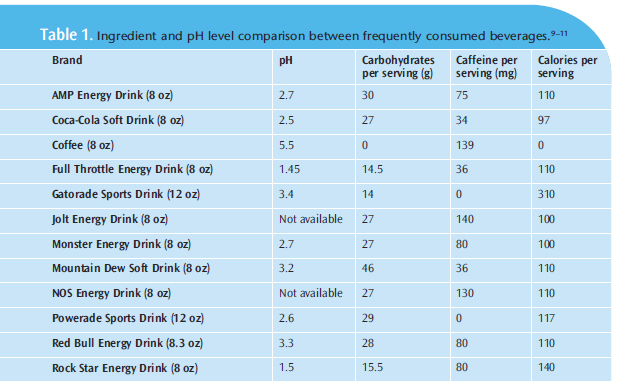
The Downside of Sports and Energy Drinks
As consumption of these beverages increases, so do the negative effects on the tooth surface, including a higher risk of erosion and dental caries.
The consumption of sports and energy drinks continues to increase as more products are introduced to the market. While sports and energy drinks are often advertised as improving performance or providing nutritional benefits, they can have devastating consequences for oral health. Dental hygienists need to be aware of the oral and systemic health effects caused by the consumption of these beverages so they can educate their patients, mitigate the resultant destruction of tooth surfaces, and promote healthy behaviors.1,2
BEVERAGE CONSUMPTION TRENDS
The fastest growing beverage categories in the United States are sports and energy drinks. More than 100 different brands are currently available.3 These beverages are popular because of their supposed ability to rehydrate the athlete after high intensity workouts and to provide energy. Many also claim to offer an improvement in sports, academic, and overall performance.1 Sports drinks generally have a low pH and contain sugars (eg, glucose, short chain glucose polymers, and sucrose). Sports drink manufacturers frequently claim these sugars can provide energy and electrolytes to substitute those lost while sweating.4
CONTENTS
The contents of sports and energy drinks vary greatly, which makes it difficult to make broad statements about their health effects. Many sports drinks contain about 6% to 8% carbohydrates (including glucose, fructose, sucrose, and maltodextrin). Other ingredients include sodium, potassium, and magnesium for electrolyte loss replacement. In active individuals, however, additional electrolytes are not needed if a well-balanced diet is maintained.

Energy drinks frequently contain caffeine and tend to have a higher carbohydrate content (9% to 10%). The large amounts of caffeine contained in energy drinks can cause wakefulness, restlessness, anxiety, insomnia, gastrointestinal upset, tremors, psychomotor agitation, and seizures.2,4–8 The amount of caffeine is not usually listed on beverage containers; instead, comparisons are used, such as “contains a similar amount of caffeine as a cup of coffee.”4 Caffeine is the most physiologically active ingredient in energy drinks and its presence often leads to the drinks’ ergogenic claims.3
CALORIE CONSUMPTION
Table 1 provides information on the specific pH, grams of carbohydrates, amount of caffeine, and calories per serving for many popular sports and energy drinks, as well as other commonly consumed beverages.9–11 Sports and energy drinks can be quite caloric—ranging from 100 calories per serving to more than 300 calories per serving. Low-carbohydrate sports and energy beverages are marketed as part of a weight maintenance program, but they often come in larger containers (16 ounces or 32 ounces) while one serving is 8 ounces. By consuming the entire bottle, calorie intake can more than double. The end result is that a high level of physical activity is needed to offset the caloric intake of these drinks.4 The consumption of caffeine-laden energy drinks can also disrupt sleep, causing fatigue, which is another risk factor for weight gain.
HEALTH EFFECTS
Both sports and energy drinks contain sugars and have a low pH, which creates an erosive and cariogenic process within the oral cavity. 1 Sports drinks are heavily marketed to athletes—from high performance athletes to weekend warriors—to help them rehydrate. However, consuming these drinks will lead to erosion and eventually decay—creating life-long oral health problems.1,4
Dental erosion is the nonbacteriogenic, acid-induced loss of anatomic tooth structure (Figure 1).3,12–14 Studies show that mandibular first permanent molars are most commonly affected by erosion that originates from sports and energy drink consumption, followed by occlusal surfaces of all other posterior teeth.12 The application of dental sealants on the mandibular teeth among those who consume sports and energy beverages is vital to preserve tooth structure.3 Root surfaces are also more susceptible to erosion than crown surfaces.2 Besides increasing the risk of weight gain due to high caloric content and the devastating effects on oral health, energy drinks present another health concern because they are often combined with alcohol. This combination exposes the user to the side effects of both alcohol and the energy drink, and may alter an individual’s perception of his or her impairment, leading to reduced impulse control.3,4

DENTAL HYGIENIST’S ROLE
Dental hygienists need to include a discussion of beverage consumption, including type, frequency, and amount, as part of a comprehensive evaluation. Adolescent boys between 14 and 15 are the largest consumers of both sports and energy drinks, so the health effects should be discussed in detail with this patient population.15 Habitual consumers of sports and energy drinks should be advised to consume the drinks quickly and not to rinse or hold the beverage in the oral cavity. Using a straw and swishing water after consuming the beverage may also assist in minimizing contact of the drink with the teeth, thereby decreasing the likelihood of decay. Additionally, frequent applications of fluoride, along with dental sealants, can assist in caries prevention. However, the best advice to offer patients is to refrain from consuming these beverages. Plain water is the best rehydrator in people who are exercising for less than 60 minutes. The general rule is to consume 1 cup to 2 cups of water every 15 minutes during the activity, with additional water after the exercise is finished. Drinking water has many benefits, including improving student readiness to learn, limiting weight gain, and preventing caries.2,4,16
CONCLUSION
The consumption of sports and energy drinks is increasing, although many people remain unaware of any health consequences. These drinks, which contain large amounts of caffeine and carbohydrates, coupled with a low pH, have the potential to cause dental caries and raise the risk of weight gain. As such, a question regarding consumption of these beverages should be included during a comprehensive written and oral health history and an individualized education program that covers the side effects of sports and energy drinks, preferable frequency and method of intake, awareness of alternative choices, topical fluoride application, and/or placement of dental sealants or restorations, should be initiated.
ACKNOWLEDGMENT
The authors would like to thank Heather Maloney and Paul Casamassimo, DDS, MS, for their assistance with this article.
REFERENCES
- Kawashita Y, Fukuda H, Kawasaki K, et al. Pediatrician-recommended use of sports drinks and dental caries in 3-year-old children. Community Dent Health.2011;28:29–33.
- Ehlen LA, Marshall TA, Qian F, Wefel JS, Warren JJ. Acidic beverages increase the risk of in vitro tooth erosion. Nutr Res. 2008;28:299–303.
- Duchan E, Patel ND, Feucht C. Energy drinks: a review of use and safety for athletes. Phys Sportsmed. 2010;38:171–179.
- Meadows-Oliver M, Ryan-Krause P. Powering up with sports and energy drinks. J Pediatr Health Care. 2007;21:413–416.
- Stegeman CA, Davis JR, Boyd LD. The Dental Hygienist’s Guide to NutritionalCare. 3rd. ed. Philadelphia: Saunders; 2010:203.
- Sullivan MG. Kids Should Avoid Energy and Sports Drinks. Available at:www.clinicalendocrinologynews.com/index.php?id=12082&cHash=071010&tx_ttnews[tt_news]=127499. Accessed September 21, 2012.
- LaBotz M. Sports, Energy Drinks Not Beneficial for Children. Available at:www.healio.com/pediatrics/adolescent-medicine/news/online/%7B99957D3D-4029-4794-B080-D20DED316D09%7D/Sports-energy-drinks-not-beneficial-forchildren.Accessed September 21, 2012.
- Lussi A, Megert B, Shellis RP, Wang X. Analysis of the erosive effect ofdifferent dietary substances and medications. Br J Nutr. 2012;107:252–262.
- Our Drinking Water. Sports Drinks vs Water. Available at: www.our-drinkingwater.com/sports-drinks-vs-water.html. Accessed September 21, 2012.
- Klimis-Zacas D. A guide to the best and worst drinks. In: Consumer Reports on Health July 2006. Dubuque, Iowa: McGraw-Hill; 2008:13-18.
- Nix S. Williams’ Basic Nutrition and Diet Therapy. St. Louis: Elsevier;2005:A8.
- Mathew T, Casamassimo PS, Hayes JR. Relationship between sports drinks and dental erosion in 304 university athletes in Columbus, Ohio, USA. CariesRes. 2002;36:281–287.
- Bryant S, McLaughlin K, Morgaine K, Drummond B. Elite athletes and ora lhealth. Int J Sports Med. 2011;32:720–724.
- Buyer DM. Are you drinking your teeth away? How soda and sports drinks dissolve enamel. J Indiana Dent Assoc. 2009;88:11–13.
- Gambon DL, Brand HS, Boutkabout C, Levie D, Veerman EC. Patterns in consumption of potentially erosive beverages among adolescent schoolchildren in the Netherlands. Int Dent J. 2011;61:247–251.
- Patel AI, Hampton KE. Encouraging consumption of water in school and child care settings: access, challenges, and strategies for improvement. Am J ofPublic Health. 2011;101:1370–1379.
From Dimensions of Dental Hygiene. October 2012; 10(10): 45-46, 49.

